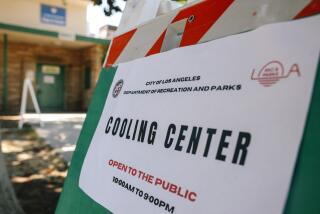2013 was one of the 10 hottest years on record; will 2014 be hotter?
Never mind the current cold snap in the East or the polar vortex that swept through much of the U.S. in early 2014 -- scientists from NASA and NOAA report that 2013 was one of the 10 hottest years on record, and there is a good chance 2014 will be even warmer.
According to the National Aeronautics and Space Administration’s calculations, 2013 is tied with 2009 and 2006 as the seventh hottest year since global temperature record keeping began in 1880.
The National Oceanic and Atmospheric Administration’s slightly different calculations say 2013 tied with 2003 as the fourth hottest year on record.
At a joint press conference on Tuesday, researchers from both agencies said that regardless of how you slice the data, the overall trend is the same: Our planet appears to be getting warmer.
“While there is year to year variability and season to season variability, the long term trends are very clear,” said Gavin Schmidt, a climatologist at NASA’s Goddard Institute for Space Studies. “And it isn’t an error in our calculation about what is happening.”
According to NASA, the average surface temperature of our planet in 2013 was 58.6 degrees Fahrenheit, which is 1.1 degrees warmer than the mid-20th century base line. That makes 2013 the 37th consecutive year that the annual global temperature was above average.
During the presentation, Tom Karl, director of NOAA’s Climatic Data Center in Asheville, N.C., noted that the dramatic warming of our planet began in the late 1960s and continued through the early part of the 21st century. Over the last decade or so, the rate of warming seems to be moving more slowly. (You can find the chart labeled “Temperature Time Series Comparison” in the gallery above.)
2013 was the hottest year on record for Australia, but here in the U.S. it was just the 37th hottest, according to NOAA’s data.
And the scientists said 2014 is likely to be warmer than 2013.
“Through the second half of 2014 we are looking at the likelihood of an El Nino, which will help warm 2014 over 2013,” said Schmidt.
Karl added that it is often difficult to predict an El Nino year before the spring, though, “so stay tuned for more on that later,” he said.
The information that NASA and NOAA used to calculate global temperature comes from more than 1,000 meteorological stations scattered throughout the world, as well as satellites that monitor sea-surface temperature and a research station in the Antarctic.
The world may be getting warmer, but science is only getting cooler. Follow me on Twitter for more like this.







